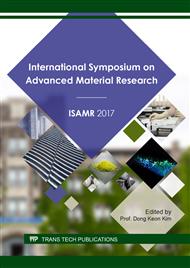[1]
L. Calabrese, A. Alenza, The effect of a liquid rubber modifier on the thermo-kinetic parameters of an epoxy resin during a pultrusion process, Comp. Sci. Tech. 63 (2003) 851-860.
DOI: 10.1016/s0266-3538(02)00269-5
Google Scholar
[2]
D. H. Li , S. C. Qi , X. A. Zhang, M. Y. Liao, Preparation, Functionalization and Properties of Low Molecular Fluoropolymers, Prog. Chem. 28 (2016) 676-685.
Google Scholar
[3]
G. Caporiccio, G. Gornowicz, U. S. Patent 5, 395, 886. (1995).
Google Scholar
[4]
G. Moggi, P. Bonardelli, G. Chiodini and S. Conti, U. S. Patent 4, 742, 126. (1988).
Google Scholar
[5]
L. C. Chiang, J. T. Lin, H. Tatsu, L. M. Kogan, A. S. Skornyakov, T. Y. Zapevalova, O. V. Blagodatova and S. V. Sokolov, U. S. Patent 5, 986, 038. (1999).
Google Scholar
[6]
W. D. Coggio, T. M. Dietz, D. R. Fronek, T. Fukushi, C. J. Nelson, D. S. Parker, T. D. Pham and K. K. Yamanaka, U. S. Patent 6, 080, 487. (2000).
Google Scholar
[7]
W. D. Coggio, T. D. Pham, U. S. Patent 5, 733, 981. (1998).
Google Scholar
[8]
M. V. Zhuravlev, O. V. Blagodatova, I. V. Kokotin, O. V. Barinov, N. V. Lebedev and V. A. Gubanov, R. U. Patent 2, 452, 746. (2012).
Google Scholar
[9]
B. Ameduri, B. Boutevin,G. Kostov. Fluoroelastomers Synthesis, properties and applications, Prog. Polym. Sci. 26 (2001) 105-187.
Google Scholar
[10]
E. F. Cluff, B. Hundred, U. S. Patent 3, 147, 314. (1964).
Google Scholar
[11]
F. Mizuide, H. Tatsu, S. V. Sokolov, U. S. Patent 6, 329, 471. (2001).
Google Scholar
[12]
J. Li, Y. F. Lu, W. T. You, L. L. Guo, C. Liu, X. A. Zhang, S. C. Qi, Synthesis, cure and properties of siloxy-terminatedliquid fluoroelastomers, Acta Polym. Sin. 11 (2013) 1430-1437.
Google Scholar
[13]
J. Li, Y. F. Lu, Y. Liu, Y. Li, X. A. Zhang, S. C. Qi, Synthesis, characterization, curing and properties of carboxyl-terminated liquid fluoropolymers, Polym. Plast. Tech. Eng. 53 (2014) 46-53.
DOI: 10.1080/03602559.2013.843688
Google Scholar
[14]
S. C. Qi, J. Li, Y. F. Lu, X. A. Zhang, J. D. Wang, Y. P. Li, Y. Li, S. L. Jiang and R. P. Yuan, CN103193919B. (2013).
Google Scholar
[15]
L. R. Saint, A. Manseri, B. Ameduri, B. Lebret and P. Vignane, Synthesis and properties of novel fluorotelechelic macrodiols containing vinylidene fluoride, hexafluoropropene and chlorotrifluoroethylene, Macromol. 35 (2002) 1524-1536.
DOI: 10.1021/ma011376f
Google Scholar
[16]
A. Taguet, B. Ameduri, B. Boutevin, Grafting of commercially available amines bearing aromatic rings onto poly (vinylidene-co-hexafluoropropene) copolymers, J. Polym. Sci., Part A: Polym. Chem. 44 (2006) 1855-1868.
DOI: 10.1002/pola.21295
Google Scholar
[17]
G. J. Ross, J. F. Wattsa, M. P. Hill, P. Morrissey, Surface modification of poly (vinylidene fluoride) by alkaline treatment 1. The degradation mechanism, Polym. 41 (2000) 1685-1696.
DOI: 10.1016/s0032-3861(99)00343-2
Google Scholar
[18]
S. R. Gondi, A. P. Vogt, B. S. Sumerlin, Versatile pathway to functional telechelics via RAFT polymerization and click chemistry, Macromol. 40 (2007) 474-481.
DOI: 10.1021/ma061959v
Google Scholar
[19]
P. Hinksman, D. H. Isaac, P. Morrissey, Environmental stress cracking of poly (vinylidene fluoride) and welds in alkaline solutions, Polym. Degrad. Stab. 68 (2000) 299-305.
DOI: 10.1016/s0141-3910(00)00015-x
Google Scholar
[20]
M. Pianca, E. Barchiesi, G. Esposto, S. Radice, End groups in fluoropolymers, J. Fluorine. Chem. 95 (1999) 71-84.
DOI: 10.1016/s0022-1139(98)00304-2
Google Scholar


